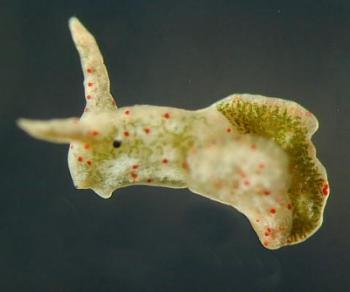
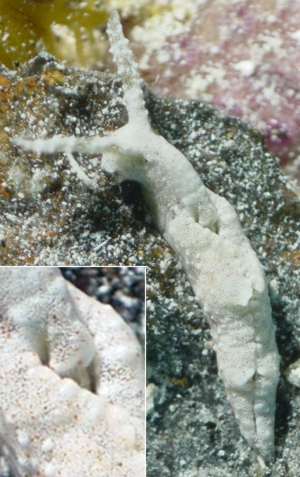
Elysia cf. timida
(Risso, 1818)
Order: SACOGLOSSA
Superfamily: ELYSIOIDEA
Family: Elysiidae
PHOTO
Upper: Florida Keys, USA. October 2000, 4mm long alive. PHOTO: Anna L. Bass.
Lower: February 03, 2004
Location: Stocking Island, Hole n°2, Great Exuma, Bahamas, Western Atlantic. Depth: 1m. Size: 15mm Photo: Marina Poddubetskaia
RELATED TOPIC
This page is for animals from the Caribbean region which are similar to the Mediterranean E. timida. There may be more than one species, one of which has been described as Elysia cornigera Nuttall, 1989. See Kathe Jensen's message [#3515] discussing the possibility that E. timida occurs on both sides of the Atlantic and reviewing published studies. See also other messages and discussion.
Reference:
• Nuttall, T.R. 1989. A new Elysia (Opisthobranchia: Ascoglossa) from the Florida Keys. The Veliger, 32: 302-307.
• Ortea, J., Moro, L. & Espinosa, J. (1997?) Nuevos datos sobre el genero Elysia Risso, 1818 (Opisthobranchia: Sacoglossa) en el Atlantico. Revista de la Academia Canaria de Ciencias, 9: 141-155.
• Risso, A. (1818). Memoire sur quelques Gasteropodes nouveaux, Nudibranches et Tectibranches observes dans la mer de Nice (1). Journal de Physique, de Chimie, d'Histoire naturelle et des Arts, Paris 87: 368-377.
Rudman, W.B., 2004 (February 18) Elysia cf. timida (Risso, 1818). [In] Sea Slug Forum. Australian Museum, Sydney. Available from http://www.seaslugforum.net/find/elyscftimi
Related messages
Re: Elysia cf. timida from the Florida Keys
July 16, 2004
From: Andrej Jaklin
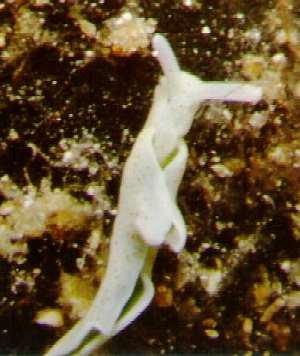
Dear Ann and Bill,
In regards to Anna's message [m12526] even without this DNA-analysis results, I would say that the specimen [message #3410] is a juvenile of "typical" E. timida. But, after seeing a lot of specimens in field, I find hard to believe that the guy in Marina's message [m12257], from the Bahamas, is the same species. The whole appearance is different, a kind of much more texturated skin surface, and rhinophores are not smooth, as I'm used to see on "my animals" here. Again, that's just my feeling and know that without some hard evidence it's not of any significance.
Ann, regarding your kind of proposal for cooperation, I'll be glad to send you some specimen of Adriatic E. timida [see photo attached]. Just let me know how many do you need (not to much, I hope) and how to preserve them. And yes, give me some reasonable time to collect them.
Regards
AJ
jaklin@cim.irb.hr
Jaklin, A., 2004 (Jul 16) Re: Elysia cf. timida from the Florida Keys. [Message in] Sea Slug Forum. Australian Museum, Sydney. Available from http://www.seaslugforum.net/find/12555Thanks Andrej,
Your message has been held up with the Forum problems. However I was talking to Anna a few days ago and I understand she has been in contact with you
Best wishes
Bill Rudman
Elysia cf. timida from the Florida Keys
March 25, 2004
From: Anna L. Bass
Hello Dr. Rudman,
I just wanted to give you an update on one of the specimens I had previously posted to the Forum. I've finally gotten around to analyzing the DNA from the tiny specimen of Elysia cf. timida found in the Florida Keys [messages :#3410, #3419, #3428, #3515]. Based on the partial sequence of one gene (cytochrome oxidase subunit I) it appears to be Elysia timida. The sequence is divergent from the Mediterranean specimen referenced in GenBank but this difference appears to be a population level divergence and not at the species level. I say this because I have found much greater sequence divergence between other species of Elysia and other members of the Family.
It would be helpful to have specimens of Elysia timida from other parts of the Atlantic to confirm that this is a population level divergence. I've not been able to access any specimens from the Mediterranean, Cuba, Bahamas or Cape Verde. Any help with this specimens/populations (and others!) would be greatly appreciated.
Best Regards and it has been fabulous seeing all the sacoglossans on the forum!!
Anna
abass@helios.acomp.usf.edu
Bass, A.L., 2004 (Mar 25) Elysia cf. timida from the Florida Keys. [Message in] Sea Slug Forum. Australian Museum, Sydney. Available from http://www.seaslugforum.net/find/12526Thanks Anna,
It's nice to have some feedback on this animal. It seems to be one of a growing number of species which are proving to be amphiatlantic.
Bill Rudman
Elysia cf. timida? from Southern Bahamas
February 20, 2004
From: Marina Poddubetskaia
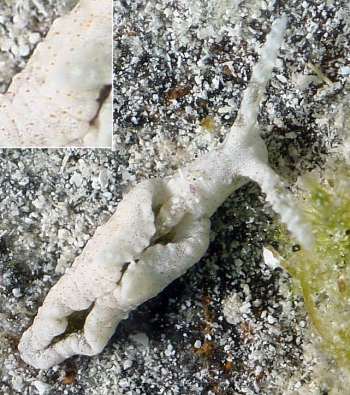

Dear Bill,
During my week in the Southern Bahamas with Anne DuPont, I've also found this very nice Elysia which looks similar to Elysia cf. timida on the Forum. I don't know if it is the same species, but it looks rather different from the Mediterranean Elysia timida :
• the rhinophores are papillate and not smooth
• the body and parapodia are papillate and not smooth too
• the red dots are smaller
So, I don't think it is Elysia timida, but I could be wrong. Could you identify this guy ? Is it another mystery to be studied ?
Also, please find attached the algae photo (2 different species) on which I found this specimen crawling. They include Acetabularia sp.(?) alga which is the food of the Mediterranean Elysia timida.
Date: February 03, 2004
Location: Great Exuma, Bahamas, Western Atlantic
Site: Stocking Island, Hole n°2
Depth: 1m
Size: 15mm
Photos: Marina Poddubetskaia - Nembro website
Cheers,
Marina.
nembro@nembro.info
Poddubetskaia, M., 2004 (Feb 20) Elysia cf. timida? from Southern Bahamas. [Message in] Sea Slug Forum. Australian Museum, Sydney. Available from http://www.seaslugforum.net/find/12257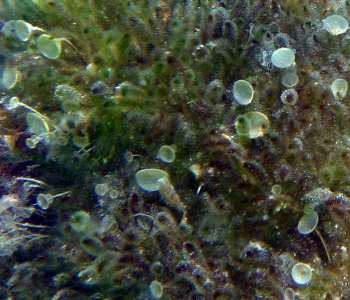
Dear Marina,
I tend to agree that externally it looks different from typical Mediterranean E. timida. You will no doubt have read Kathe Jensen's message [#3515] where she discusses whether the Mediterraneam and Caribbean are colour variants of the same species, or whether there are two very similar species, perhaps with wide overlapping distributions. Your animals fit the original description of Elysia cornigera Nuttall, 1989 very well. However Ortea et al (1997) consider it to be a synonym of E. timida. Looking at Anna Bass's photo [#3410] of a small damaged? specimen with bright red spots, it is possible that E. timida and E. cornigera are different, but related, species, both feeding on the alga Acetabularia in Caribbean waters.
As you say, I guess this is another mystery, still to be studied.
Best wishes
Bill Rudman
Re: Elysia cornigera from Florida
January 15, 2001
From: Kathe R. Jensen
Dear Bill,
Happy New Year.
Sorry I have taken so long to comment on Anna's Elysia, but first week of classes has been completely chaos, rescheduling and re-rescheduling classes, signing registration forms, plans of study - plus catching up with the huge pile of mail that had accumulated while I was in Denmark for the holidays. And I had to check some references before I could send an answer for the readers of the Forum.
Ortea et al. (1997? - I don't think this was actually published till 1999) compared specimens from the Cape Verde Islands and from Cuba, and tentatively synonymized Elysia timida and E. cornigera. My Spanish is very poor, but I don't think they studied anatomy apart from radular teeth.
In the eastern Mediterranean (Israel) Elysia timida has been described to have encapsulated (direct) development, i.e. the larval shell is lost prior to hatching (Rahat, 1976). In the western Mediterranean a seasonal change from encapsulated to lecithotrophic development (swimming, but non-feeding veligers) has been described (Marin & Ros, 1993). When Nuttall described his E. cornigera (Nuttall, 1989) he also described the larval development, but unfortunately the large larvae died prior to hatching, so either lecithotrophic or encapsulated development was predicted. All this leaves us with a number of possibilities:
•(1) There is only one widespread species with a variable development pattern,
•(2) There are 2 species whose range overlap in the western Mediterranean,
•(3) The population in Florida and Cuba (whether there is one or two species) has been introduced by human activities (ballast water, f.ex.),
•(4) The Mediterranean population could be an early, and higly successful, introduction (not very likely, I think).
These hypotheses should be tested by using phylogenetic analysis, and I hope I have provoked Anna to make the attempt. There are two likely sister species occurring in Australia: Elysia filicauda Jensen & Wells, 1990, which also feeds on Acetabularia, but with unknown development pattern, and Elysia thompsoni Jensen, 1993, with unknown diet, but presumed planktotrophic development (very small egg capsules). Both species have the peculiar teeth with lateral, more or less denticulated flanges.
Thus, I suggest that you move the species to a new page named Elysia cf. timida Risso, 1818. And then we await the progress of science.
References:
• Jensen, K.R. 1993. Sacoglossa (Mollusca, Opisthobranchia) from Rottnest Island and central Western Australia. Pp. 207-253 in: The Marine Flora and Fauna of Rottnest Island, Western Australia (eds. F.E. Wells, D.I. Walker, H. Kirkman & R. Lethbridge). Western Australian Museum, Perth.
• Jensen, K.R. & Wells, F.E. 1990. Sacoglossa (=Ascoglossa) (Mollusca, Opisthobranchia) from southern Western Australia. Pp. 297-331 in: The Marine Flora and Fauna of Albany, Western Australia. Western Australian Museum, Perth.
• Marin, A. & Ros, J. 1993. Ultrastructural and ecological aspects of the development of chloroplast retention in the sacoglossan gastropod Elysia timida. Journal of Molluscan Studies 59: 95-104.
• Nuttall, T.R. 1989. A new Elysia (Opisthobranchia: Ascoglossa) from the Florida Keys. The Veliger, 32: 302-307.
• Ortea, J., Moro, L. & Espinosa, J. (1997?) Nuevos datos sobre el genero Elysia Risso, 1818 (Opisthobranchia: Sacoglossa) en el Atlantico. Revista de la Academia Canaria de Ciencias, 9: 141-155.
• Rahat, M. 1976. Direct development and symbiotic chloroplasts in Elysia timida (Mollusca: Opisthobranchia). Israel Journal of Zoology, 25: 186-193.
Kathe Jensen
jensen@ait.ac.th
Jensen, K.R., 2001 (Jan 15) Re: Elysia cornigera from Florida. [Message in] Sea Slug Forum. Australian Museum, Sydney. Available from http://www.seaslugforum.net/find/3515Thanks Kathe,
For your ideas and the list of references which will be a great help for people interested in these fascinating little animals. I have taken your advice and made a Elysia cf. timida Page.
Best wishes,
Bill Rudman
Re: Elysia cornigera from Florida
December 24, 2000
From: Anna L. Bass
Dear Dr. Rudman,
When I first started trying to figure out what species I had found, my thought was E. timida. As I couldn't find any records for it outside of the Meditterranean, I had doubts. Although I found it on Caulerpa, I didn't assume it was feeding on that, and Acetabularium was present in the area.
Thanks for your opinion regarding this. Hopefully, I will be able to confirm the presence of E. timida in Florida. Anyone in the Meditteranean willing to send a specimen of E. timida for molecular analysis?
Best Regards and Happy Holidays,
Anna
Anna L. Bass
Department of Biology, SCA 110
University of South Florida
4202 E. Fowler Ave.,
Tampa, Florida 33620-5150
abass@helios.acomp.usf.edu
Bass, A.L., 2000 (Dec 24) Re: Elysia cornigera from Florida. [Message in] Sea Slug Forum. Australian Museum, Sydney. Available from http://www.seaslugforum.net/find/3428Dear Anna,
It's certainly interesting. Probably worth having another look at the radula of the two as well - and checking out Acetabularia for some more specimens.
Two questions spring to mind. Is Elysia cornigera just a colour form of Elysia timida? It is possible that radular differences may not be so different if a number of animals from both the Caribbean and Mediterranean are looked at. It could also be possible, though probably unlikely that both E. timida and E. cornigera both occur in the Caribbean. What it seems to me is needed is quite a few more specimens to study variability in colour and anatomy. Even if you show there are molecular differences between your two specimens from the Caribbean and Mediterranean animals, it still doesn't demonstrate that there is only one species in the Caribbean.
Like many observations we make, your animals to raise more questions than they resolve.
Best wishes,
Bill Rudman.
Re: Elysia cf cornigera from Florida
December 23, 2000
From: Bill Rudman
Dear Anna,
In reference to Anna's message about the red-spotted Elysia. I have found the Nuttall reference. It's:
Nuttall, T.R. (1989) A new Elysia (Opisthobranchia: Ascoglossa) from the Florida Keys. The Veliger, 32(3): 302-307
Elysia cornigera is described as having a colourless body with bright green digestive diverticula and small brilliant red and pale orange granular spots. In the description the pale orange spots are larger than the red ones. The red spots don't seem as large as in Anna's photos. Elysia cornigera feeds on Acetabularia crenulata and in many ways is very similar to the Mediterranean Elysia timida Risso 1818 which also feeds on Acetabularia.
E. cornigera is said by Nuttall to differ from E. timida in having pointed extensions of the parapodial edge (2 each side?), a warty skin, orange spots and in having a differently shaped radular tooth
Having a look at the many photos of E. timida on Erwin Koehler's Mediterranean Slug Site, it would seem there is enough colour variation in size and number of red spots to wonder whether E. timida is amphiatlantic, with populations in both the Mediterranean and the Atlantic. In those photos you can clearly see the extensions of the parapodial edge which are supposedly exclusive to E. cornigera.
Best wishes,
Bill Rudman.
--
Elysia cornigera (?) from Florida
December 21, 2000
From: Anna L. Bass

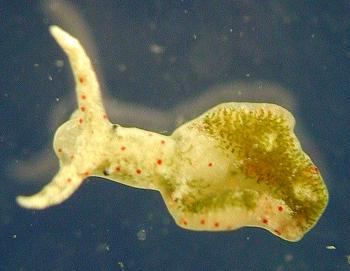
Hello Dr. Rudman,
I'm working in Florida and hoping to take a look at the systematic relationships among sacoglossans with emphasis on the Elysiidae. In the process of collecting some specimens in the Florida Keys during October of this year, I spotted two individuals of an Elysia species. (They were like little Christmas trees, which is appropriate for this time of the year!) I found them on a canal wall face just below the surface on Caulerpa verticillata. I managed to keep one alive for a couple of months and it reached a size of 4mm. The closest description of a named Elysia that I can find is that for Elysia cornigera Nuttall, 1989. Any help with the id would be appreciated. Sorry about the quality of the photos.
Thanks for providing such a wonderful resource and Forum.
Best Regards,
Anna L. Bass
abass@helios.acomp.usf.edu
Bass, A.L., 2000 (Dec 21) Elysia cornigera (?) from Florida. [Message in] Sea Slug Forum. Australian Museum, Sydney. Available from http://www.seaslugforum.net/find/3410Dear Anna,
At 4mm you do not need to apologise for your photos!
It is definitely a pretty little animal and with those red spots it should be recognisable to someone. I'm afraid I am not familiar with the Nuttall reference and my database has let me down so if you could give me a full citation I would be grateful.
If you watch the Forum for the next few days I am sure we will get a name, if there is one. I am glad someone is continuing to work on the sacoglossans of the Caribbean. If you have photos of even the most common species, and are willing to send them to the Forum, I am sure a lot of us would be interested.
Best wishes,
Bill Rudman.
